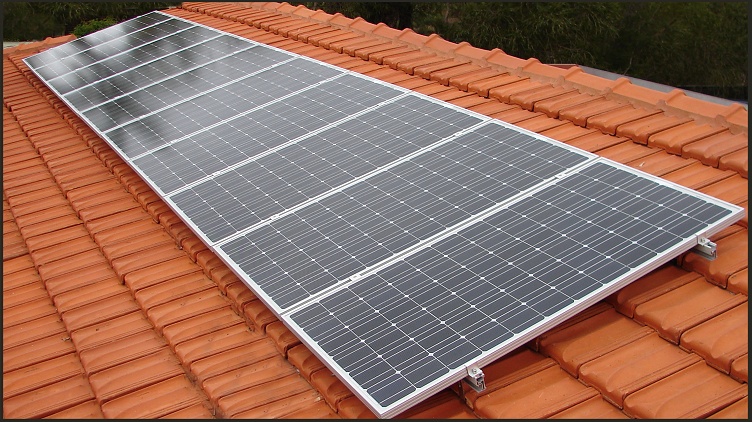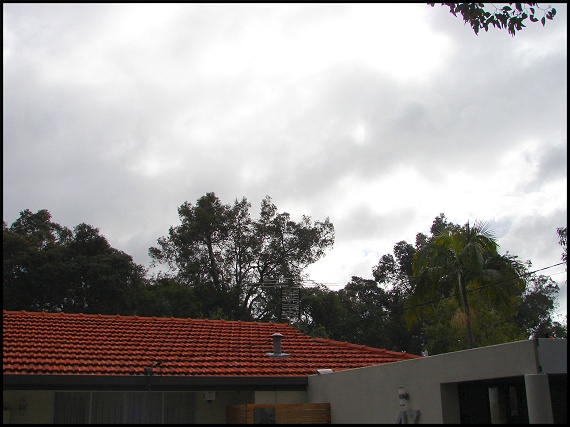
Solar panels installed on our house in Gooseberry Hill
| The 2 kW system was installed on a
completely overcast day and was switched on at 1PM. Even with complete
light cloud cover the system produced 500 Watts. The cloud cover
thickened and at 3PM was down to 100 Watts. How does it do it...?
At 4.30PM the system was producing 6 watts. If this 6 watts really is being used, how is this possible that the inverter is able to feed such a small amount of power into the house? If I put 2 generators in parallel, they share the load, you can't have one provide its full output while the other very little. Perhaps the inverter ups the 240 volt output so it is always a bit higher than the grid supply.....? Some answers
After having read an article in Silicon Chip about Solar Power Inverters, I know a bit more about how the Inverter is able to feed all of the available power back into the grid or household. The Inverter runs at a slightly higher voltage than the grid supply and a slightly advanced phase. This pushes any excess power back into the grid and also makes sure that any available power is used in the household. Working well
What has surprised me most is just how much power is being generated during the least Sun time of the year. The maximum power seen so far is 1.8 kW, almost the full 1.9 kW that the system is rated for. Interesting also is this was when there was thin hazy cloud, not full blue sky Sun. On any day during July there has not been any time when the system has not been producing power, even when it is raining, there is still several hundred watts being produced.  Solar output on cloudy winter's day  Cloudy day with no full Sun producing 578.1 watts Since
installation on the 17th June 2011 to the 26 July 2011, a total of
39 days, the solar installation has produced 144 kWh which is an
average of 3.7 kWh per day. The maximum during summer, at a
guess, should be 15 kWh.
|
|
Home Solar Installations
Milan VK6KTV I am an electrician with Solar design/ installer accreditation and would like offer you some points. I would recommend that you look at least a 1.5 kW solar system as at this size the government pays the maximum rebate of 31 REC'S X 5 multiplier = 155 REC's. Each REC has a dollar figure that varies up to $40/REC X 155 REC's = up to $6200 max. Any solar panel additions above 1.5 kW get the standard rate of REC's worked out(no multiplier). So if you asked for a 3kW solar system then the first 1.5kW will get a rebate up to $6200. The next 1.5kW will get a rebate of $1240 = Total rebate of $7440.(best case scenario) Most salespeople will say their systems that they sell are the best quality and so on, This is not the case as you generally pay for what you get. The main difference in cost will be in the type of inverter supplied. Inverters: One supplier told me that they would not sell me their old entry level Chinese Inverter. I was told by another salesman that several of the same cheaper inverters have been the cause of several house fires. The next cheapest model available(aussie built) cost $600 more. Stick with a known established brand, I would not recommend a transformerless model to an Amateur Radio license holder due to RFI concerns. My solar supplier confirmed that was the case where many transformerless inverters were installed in a retirement village causing widespread problems with the AM broadcast band. Inverter size: When choosing an inverter also consider if there is chance of future expansion. With the price of electricity going up and solar panel prices dropping you might regret it later if you don't. Solar panels: Most solar panels on the market are Chinese made and of good/reasonable quality. There is some other top of the range German/USA makes available for higher cost. Solar Panel Efficiency: Depending on your how much roof space you have ideally facing north, if not east or west then this can be an issue. Different panel types have different efficiencies, So needing more roof space to get the desired KW rating of panels fitted. MonoCrystalline Panels - typically 18% + efficiency PolyCrystalline - 15% + efficiency Thin Film Panel - typically 10.5% + efficiency Power Rebate: Synergy are paying 7 cents a KWH (this is what they say it costs to produce??) + the state government are topping this up with another 40 cents a KW/H for 10 years, the total now 47 cents per KW/Hour. The savings usually give an average of a 5 year payback on your outlay after the rebate. Metering: Your meter will have to be reprogrammed to be an import/Export type. The tariff you choose can be either the A1 or Smartpower. Smartpower might not be a good choice if people are home during the day. Most people choose the A1 tariff. Hope this helps Cheers Milan Vasich VK6KTV |